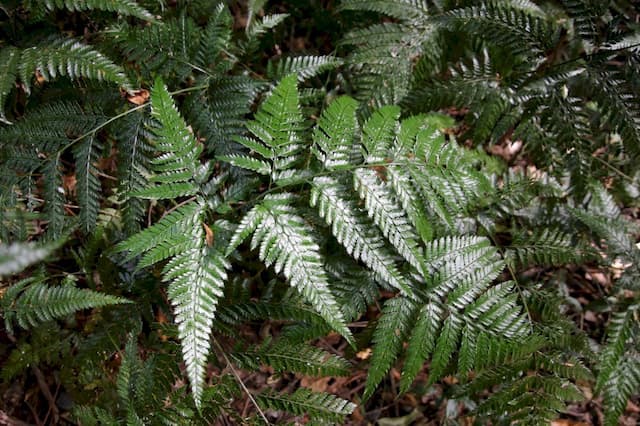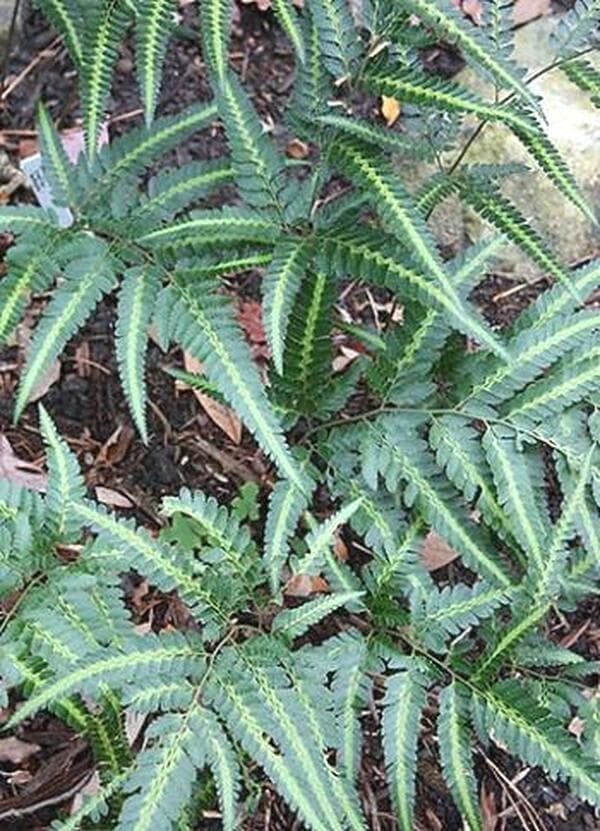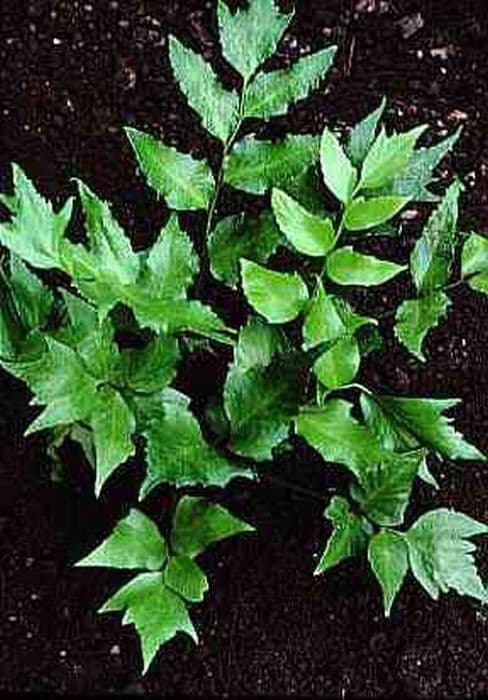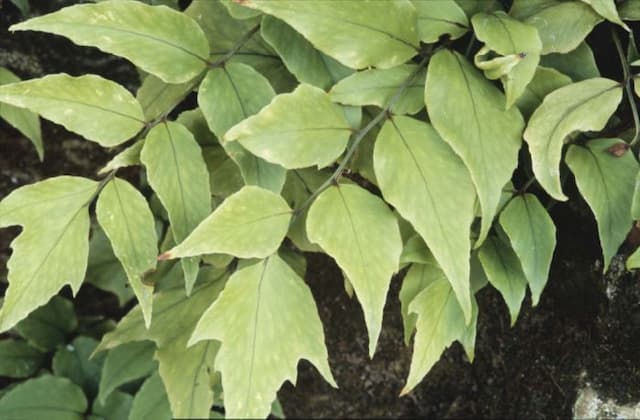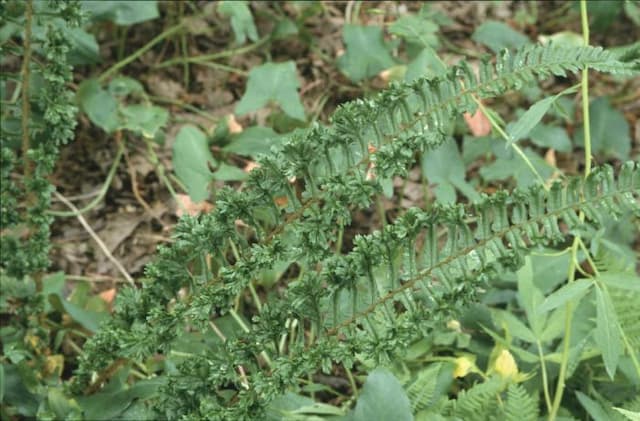Golden Male Fern Dryopteris affinis 'Grandiceps Askew'

ABOUT
The Golden Male Fern 'Grandiceps Askew' is a type of fern noted for its lush, arching fronds that create an elegant and textured display. The leaves are a vibrant green, divided into numerous small leaflets with delicately serrated edges, which give the plant a feathery, intricate appearance. The overall shape of the fronds is broad at the base, narrowing towards the top, and the tips of the fronds are uniquely tasseled, adding an ornamental touch to this variety. During its growth, new fronds unfurl from the center of the plant, emerging as tightly coiled spirals that are often referred to as fiddleheads, a characteristic shared by many ferns. This fern possesses a graceful and clumping habit, with the fronds radiating outwards from a central point, creating a somewhat vase-like silhouette. The leafy branches are supported by sturdy, upright stalks, which contrast against the soft texture of the leaves. The coloration and the lushness of 'Grandiceps Askew' make it a favorite for adding a touch of woodland charm to shaded garden areas. The feathery complexity of its foliage invites close inspection and rewards gardeners with year-round interest, albeit with variations depending on seasonal changes.
About this plant
 Names
NamesFamily
Dryopteridaceae
Synonyms
Golden Male Fern, Scaly Male Fern
Common names
Dryopteris pseudomas (Wollaston) Holub, Dryopteris borreri (Newman) Woyn. & Ching, Lastrea affinis (Lowe) Bory, Nephrodium affine Lowe.
 Toxicity
ToxicityTo humans
The common name for Dryopteris affinis 'Grandiceps Askew' is golden male fern. This plant is not commonly known to be toxic to humans. However, it is always recommended to exercise caution and avoid ingesting any part of ornamental plants due to the general risk of stomach irritation or allergic reactions. If you suspect poisoning, seek medical attention.
To pets
The common name for Dryopteris affinis 'Grandiceps Askew' is golden male fern. This fern is not known to be toxic to pets. However, pets should not be encouraged to eat ornamental plants as they could cause stomach upset or an allergic reaction. If your pet has ingested a plant and is showing signs of illness, consult with a veterinarian.
 Characteristics
CharacteristicsLife cycle
Perennials
Foliage type
Evergreen
Color of leaves
Green
Height
3 feet (91 centimeters)
Spread
3 feet (91 centimeters)
Plant type
Fern
Hardiness zones
5-9
Native area
Western Europe
Benefits
 General Benefits
General Benefits- Ornamental Appeal: The lacy fronds and attractive rosette form provide visual interest in gardens and landscapes.
- Shade Tolerance: Thrives in shady areas where other plants may struggle, making it a valuable addition to woodland gardens and shaded beds.
- Low Maintenance: Requires minimal care once established, making it a convenient choice for busy gardeners and low-maintenance landscapes.
- Drought Resistance: Can withstand periods of dryness once established, reducing the need for frequent watering.
- Wildlife Habitat: Provides shelter and food for birds, insects, and other wildlife, contributing to biodiversity.
- Cold Hardy: Resilient to cold temperatures, making it suitable for a wide range of climates and useful for year-round interest in gardens.
- Erosion Control: The dense root system helps stabilize soil and prevent erosion, especially on slopes or in areas with loose ground.
- Winter Interest: Evergreen in many climates, offering greenery and structure to the garden even in the colder months.
 Medical Properties
Medical PropertiesThis plant is not used for medical purposes.
 Air-purifying Qualities
Air-purifying QualitiesThis plant is not specifically known for air purifying qualities.
 Other Uses
Other Uses- Dye Production: Dryopteris affinis 'Grandiceps Askew', commonly known as the Scaly Male Fern, can be used to create a natural dye, often resulting in shades of yellow, green, or brown when applied to textiles.
- Garden Design: Scaly Male Ferns can be planted en masse to create a lush, textured backdrop in shady woodland gardens, emphasizing their ornamental value beyond individual plantings.
- Erosion Control: Due to their robust root system, these ferns can be used on slopes or banks to help prevent soil erosion in damp, shaded environments.
- Aquascape Accent: While not a true aquatic plant, Scaly Male Ferns can be used around pond edges or water features to provide a naturalistic look and enhance the aquatic landscape with their foliage.
- Habitat Restoration: Scaly Male Ferns can be instrumental in restoring native woodlands and forest understorey, as they are native to certain regions and support the local ecology.
- Craft Material: The fronds of the Scaly Male Fern may be used in floristry or as a unique component in natural craft projects, such as wreath-making or decorating.
- Living Mulch: When planted densely, Scaly Male Ferns can act as a living mulch, suppressing weeds and maintaining soil moisture in shaded garden areas.
- Companion Planting: These ferns can be strategically placed with shade-loving perennial flowers to create a synergistic effect that enhances the visual appeal of garden beds.
- Bioindicator: Scaly Male Ferns, like other ferns, could serve as bioindicators of environmental quality, particularly in relation to shade and moisture levels in an area.
- Photography Subject: The intricate details and lush greenery of the Scaly Male Fern make it an excellent subject for botanical photography, highlighting the diversity of textures within the plant kingdom.
Interesting Facts
 Feng Shui
Feng ShuiThe Golden Male Fern is not used in Feng Shui practice.
 Zodiac Sign Compitability
Zodiac Sign CompitabilityThe Golden Male Fern is not used in astrology practice.
 Plant Symbolism
Plant Symbolism- Endurance: As a fern species, Dryopteris affinis, commonly known as the Golden Scaled Male Fern, often symbolizes endurance due to its hardy nature and ability to thrive in shady, forest environments.
- Solitude: Given its preference for the quiet and less disturbed areas of woodlands, this fern can represent solitude and the tranquility of being alone.
- Ancient Wisdom: Ferns are an ancient group of plants, with a long history predating many modern plant species, so the Golden Scaled Male Fern can be seen as a symbol of ancient wisdom and timelessness.
- Secret Bond: In the Victorian language of flowers, ferns were generally associated with secret bond of love or hidden feelings, thereby the Golden Scaled Male Fern may subtly suggest an unspoken emotional connection.
- Shelter: Ferns often create a microhabitat that offers shelter to small animals and insects. Analogously, the Golden Scaled Male Fern may symbolize shelter, protection, and home.
 Water
WaterGolden-scaled male fern should be watered thoroughly whenever the top inch of soil feels dry to the touch. This may mean watering approximately every 7 to 10 days, but frequency will vary depending on the humidity and temperature conditions of your environment. It's important to provide enough water to moisten the soil all the way to the roots; for a medium-sized fern, this could be about 16 to 32 ounces per watering session. Avoid letting the plant sit in standing water, and reduce watering in the winter when plant growth is slower.
 Light
LightThe Golden-scaled male fern thrives best in partial shade to full shade. The ideal location for this fern would be an area that receives dappled sunlight or indirect light throughout most of the day. Direct sunlight can be damaging, causing the fronds to lose their lush green color and become scorched.
 Temperature
TemperatureThe Golden-scaled male fern does well in average room temperatures, ideally between 60 to 75 degrees Fahrenheit. This fern can survive temperatures as low as 55 degrees but will start to suffer if exposed to temperatures below that. It's also important to keep the plant away from drafts or heating vents, which can cause undue stress.
 Pruning
PruningPruning the Golden-scaled male fern is typically done to remove any dead or damaged fronds and to maintain plant shape and size. The best time to prune is in the spring before the new fronds unfurl. This task is not required frequently, often only once a year or as needed when you notice browning or damaged fronds.
 Cleaning
CleaningAs needed
 Soil
SoilThe best soil mix for the Golden Shield Fern should be rich, well-drained, and high in organic matter, with a slightly acidic to neutral pH of 6.1 to 7.2. A mix of garden soil, compost, and perlite or coarse sand will provide the necessary drainage and nutrients.
 Repotting
RepottingGolden Shield Fern should typically be repotted every 2 to 3 years or when it outgrows its current container, which is when you can see roots coming out of the pot's drainage holes.
 Humidity & Misting
Humidity & MistingGolden Shield Fern thrives in high humidity levels, preferably between 60% and 80%. Aim to maintain a consistently humid environment without letting the foliage stay wet, which may lead to fungal issues.
 Suitable locations
Suitable locationsIndoor
Place in filtered light, keep moist, and maintain humidity.
Outdoor
Choose shaded area, keep soil moist, protect from wind.
Hardiness zone
5-9 USDA
 Life cycle
Life cycleThe life cycle of Dryopteris affinis 'Grandiceps Askew', commonly known as the Golden Male Fern, begins with spore germination, where the tiny, dust-like spores develop into a heart-shaped gametophyte (prothallus). The prothallus houses both male and female reproductive organs, and under suitable moisture conditions, fertilization occurs leading to the formation of a new sporophyte. The juvenile sporophyte then emerges and gradually develops into a young fern with characteristic fronds uncoiling from the center – a process known as circinate vernation. As the plant matures, these fronds grow and differentiate, resulting in the distinct "tassel" appearance at the tip, which gives the 'Grandiceps Askew' its ornamental value. The mature fern reaches a size where it can produce clusters of spores on the undersides of the fronds, in structures known as sori, completing its reproductive cycle. The fern maintains a perennial lifestyle, with fronds typically dying back in winter, to re-emerge from the rhizome with the onset of favorable growing conditions in spring.
 Propogation
PropogationPropogation time
Spring to Summer
The most popular method of propagating the Dryopteris affinis 'Grandiceps Askew', commonly known as the Golden-scaled male fern, involves division. This is typically done in the spring, just before new growth starts. Carefully dig up the parent fern, taking care to minimize root disturbance. Then, using a sharp knife or spade, divide the clump into smaller sections, each with a portion of the root system and several fronds. Replant these divisions into a moist, shaded location, at the same depth they were growing before. Water them well to settle the soil around the roots and eliminate any air pockets. It's important to keep the newly planted divisions well-watered until they are established, which usually takes a full growing season.
